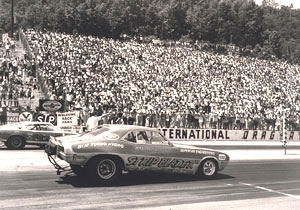
Bristol Motor Speedway
A favorite track of NASCAR fans across the nation is the Bristol Motor Speedway. Its two annual Winston Cup events (currently the Food City 500 in April and the Goody’s 500 in August) attract the largest crowds of any sporting events in the state of Tennessee. The “World’s Fastest Half Mile” (actually .5333 mile) is legendary for its tight, competitive races and for the deafening roar reverberating off the surrounding hills as the stock cars circle the track.
Bristol entrepreneurs Larry Carrier, Carl Moore, and R. G. Pope built what was then called the Bristol International Speedway in 1960-61 as a perfect half-mile oval with twenty-two-degree banking in the turns. The original facility had a seating capacity of over 18,000, making it one of the larger tracks at a time when most NASCAR Grand National (now Winston Cup) venues could accommodate fewer than 10,000 fans. Carrier also built a football field in the infield of the track in hopes of attracting NFL preseason games. Johnny Allen won the first Grand National race at Bristol driving in relief of Jack Smith (who received official credit for the first victory) in the inaugural race of July 30, 1961.
In 1969 the track was reconfigured to its current .533 mile length and the banking on the turns was increased to thirty-six degrees, with sixteen-degree banking in the straights, the steepest banking in Winston Cup racing. Seating capacity was also expanded to over 30,000. The changes on the track dramatically boosted top qualifying speeds from 88.669 mph in the spring race of 1969 to 103.432 mph in the summer race on the reconfigured track. Initially, the higher speeds caused numerous wrecks and mechanical failures, and only ten out of thirty-two cars completed the first race. After the race NASCAR superstar Richard Petty complained: “If you ask me, they ruined a good race track. There’s not enough room for the speeds we’re running.” (1) The drivers and mechanics soon adjusted to the higher speeds, however, and the attrition rate declined, although Bristol is still known as a track which combines the high speeds of the superspeedways with the rough-and-tumble bumping–“swapping paint” in NASCAR parlance–of the short tracks. The race qualifying record now stands at 125.093 mph set by Mark Martin in 1995. Tennessean Darrell Waltrip holds the record for most Winston Cup victories at the track with twelve, including seven consecutive races between 1981 and 1985.
Bruton Smith’s Speedway Motorsports–owners of Charlotte Motor Speedway, Texas Motor Speedway, Sears Point Raceway, and Atlanta Motor Speedway–bought the track from Carrier in 1996. The track’s name was officially changed to Bristol Motor Speedway in May 1996. Speedway Motorsports has poured millions of dollars into the facility, making Bristol the largest and one of the most modern sporting venues in the state. Seating capacity was enlarged from 71,000 to over 131,000 in 1998–including one hundred skybox suites–and mountains were bulldozed to improve accessibility to the facility. By March 2000, seating capacity was increased to 147,000 with the opening of the Kulwicki Terrace and Kulwicki tower addition. Bristol Motor Speedway now annually hosts two Winston Cup races, two Busch Grand National races, and one race each in the Craftsman Truck Series, the Slim Jim/All Pro Series, and the Goody’s Dash Series. It celebrated its fortieth anniversary in 2001.



